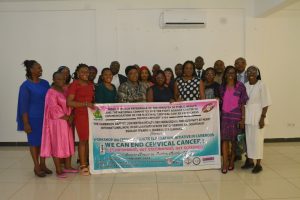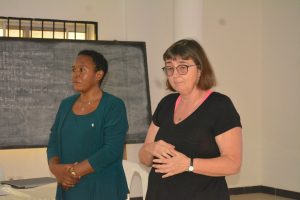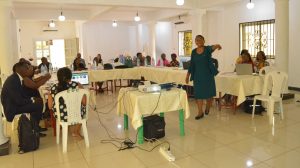
Story, Louvier Kindo Tombe
Eveline had never seen someone suffering from cervical cancer until her mother was tested positive of the disease. “I thought my mum had been bewitched,” Eveline said. Her mother who lived in one of the remote villages in Ndu Sub Division, Bui Division of the North West region died some 10 years ago, shortly after testing positive for cervical cancer. The last words from her mother on her sick bed were “my dauugther, even if you are very healthy, always go for checkup to avoid situations like what I’m going through”.
“Cervical cancer is a real threat to the lives of women in Cameroon,” says Ms. Florence Manjuh, from the women health program of the CBC Health Services.
She was speaking during a workshop with journalists and civil society organizations on cervical cancer elimination strategies. The workshop organized by civil society organization, Humanity at Heart International, in collaboration with the CBC Health Services and the National Committee for the Fight Against Cancer, held in Yaounde on January 19, 2024 on the theme “we can end cervical cancer, get informed, get vaccinated, get screened”. The objective of the workshop was to enjoined the media and civil society organizations to take action towards preventing cervical cancer.

Cervical cancer is the fourth most common form of cancer amongst women in the world. It is the fourth leading cause of death among women. A woman dies of cervical cancer in the world every two minutes. In Cameroon, five of eight woman diagnosed everyday of cervical cancer die.
These statistics are disturbing and frightening but the good news is that cervical cancer is the only cancer with known causes. It is caused mainly by a virus known as human papillomavirus (HPV). HPV is a common virus that is passed from one person to another during sex or even body contacts mostly around the laps.
Having sex with multiple partners, early sex, and smoking can increase your risk of developing cervical cancer. Also, women who have given birth to more than five children, and those not having routine cervical cancer screening tests (Pap tests) are at risks of picking the disease.
Another very important risk factor is male uncircumcision. Uncircumcised men are are high risk or contracting and spreading cervical cancer.
“This is because the top-end layer of their penis that has not been cut off through circumcision serves as a good reservoir for the HPV virus,” Dr. Manga Simon told participants at the workshop in Yaounde as he encouraged all and sundry to embrace early screenings and vaccinations as key in cervical cancer treatment.
Eliminating cervical cancer

The pains of loosing her mother doubled when Tata Eveline, discovered that cervical cancer, though deadly is preventable and could be treated if captured early. Today Eveline is a health advocate, Executive Director of an organization, Humanity at Heart International based in Buea, South West region of Cameroon. She joined the fight against cervical cancer to prevent people from suffering from what took away the life of her mother.
“So I decided to do advocacy, to make sure that everyone becomes fully engaged, in creating awareness, in making sure that women get screened early enough,” she said.

Cervical cancer prevention is done in two folds. Primary prevention basically through vaccinations and secondary prevention through screenings and treatment.
“Vaccination is more effective before the first sexual intercourse”, says Dr. Simon Manga, from the CBC Health Services.
The different health experts at the training workshop revealed that children are vaccinated from the age of 9 years. In Cameroon, vaccination is free at the age of 9 to 15 for both boys and girls. Vaccination protects the spread and transformation of the HPV virus in humans, reducing the effects to zero, and thus contributes to eliminating the cancer from the body.
“Now is the time to act to eliminate cervical cancer as a public health problem,” Tata Eveline said.
Besides vaccination, it is advisable for women to screen for cervical cancer. It develops very slowly in the body. It can take years or even decades for the abnormal changes in the cervix to become invasive cancer cells. It can however develop faster in people with weaker immune systems.
“After 24 months, the virus becomes persistent and that is where the problem starts,” Ms Manjuh Florence said.
Cancer is thus preventable during the pre-cancer period of less than 24 months, from infection day (latency period). One of the reasons for the high rate of cervical cancer in Cameroon is ignorance. Many people are not even aware that it exists. The few that are aware cannot benefit from treatment because of poverty. The government has however come up with options of vaccination which is free, and other organizations in the country like the CBC Health Services are providing free screenings.
The cost of cancer treatment in Cameroon is also very high, that is why the government is actually subsidizing the treatment but yet much still need to be done.
For the first time in the history of mankind, the World Health Organization (WHO) has come up with strategies that can be used to eliminate a cancer.
In May 2018, the WHO Director-General announced a global call for action to eliminate cervical cancer, underscoring renewed political will to make elimination a reality and calling for all stakeholders to unite behind this common goal.
In August 2020 the World Health Assembly adopted the Global Strategy for cervical cancer elimination.
To eliminate cervical cancer, all countries must reach and maintain an incidence rate of below four per 100 000 women. Achieving that goal rests on three key pillars and their corresponding targets.

– Vaccination: 90% of girls fully vaccinated with the HPV vaccine by the age of 15;
– Screening: 70% of women screened using a high-performance test by the age of 35, and again by the age of 45;
– Treatment: 90% of women with pre-cancer treated and 90% of women with invasive cancer managed.
The cervical cancer elimination workshop was organised within the framework of the cervical cancer awareness month to push an advocacy in respecting these targets.
“Each country should meet the 90-70-90 targets by 2030 to get on the path to eliminate cervical cancer,” says Tata Eveline Mayaah.
Representing the government at the workshop was the deputy Permanent Secretary of the National Committee for the Fight Against Cancer, Dr. Essono Justine. The committee she said has a road map to eliminate cancer in the country and would need the services of all stakeholders especially the civil society and media to meet up the deadline of 2030.








